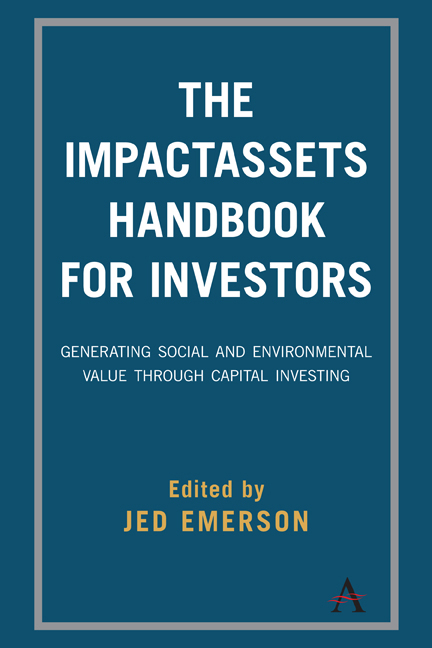 The ImpactAssets Handbook for Investors
The ImpactAssets Handbook for Investors Book contents
- Frontmatter
- Dedication
- Contents
- List of Contributors
- Preface
- Introduction
- 1 Construction of an Impact Portfolio: Total Portfolio Management for Multiple Returns
- 2 Total Portfolio Management: One Practitioner's Approach
- Case Study 1
- Case Study 2
- Case Study 3
- 8 The Measurement Challenge
- Case Study 4
- Appendix: Impact Investing Resources
- Notes on Contributors
- Index
- Frontmatter
- Dedication
- Contents
- List of Contributors
- Preface
- Introduction
- 1 Construction of an Impact Portfolio: Total Portfolio Management for Multiple Returns
- 2 Total Portfolio Management: One Practitioner's Approach
- Case Study 1
- Case Study 2
- Case Study 3
- 8 The Measurement Challenge
- Case Study 4
- Appendix: Impact Investing Resources
- Notes on Contributors
- Index
Summary
IMPACT INVESTOR CASE STUDY: “BEN CARTER”
Year Started Impact Investing: 2005
Primary Focus: Total Portfolio Management of all family assets
Background: In 2000, Silicon Valley entrepreneur Ben Carter emerged from the tech IPO boom with a pile of cash and the desire to make a positive impact on the world. The company that Ben had stock options in had gone public and he became a millionaire overnight.
Impact Trigger
In 2001, Ben met with a financial advisor to devise a plan for deploying his new wealth. When he asked what investment opportunities there were to put his money to work for positive impact, the advisor wasn't sure if there were such options but pointed him toward environmental social governance (ESG) mutual funds. ESG mutual funds screen out companies based on specific criteria, such as tobacco. The impact that Ben wanted to make was bigger and different than simply “screening out the bad.” He didn't want to make more money with his money but wanted to invest with people he trusted and in ideas and ventures that excited him. Helping innovative social entrepreneurs, for instance, or lending money to small business owners in the community were of interest to him. The entrepreneurial spirit was part of Ben's DNA and he wanted to integrate his interests and intentions in something personal, understandable and on a human scale.
Ben continued to search for a different answer and eventually found his way into impact investing, a way of investing that seeks a financial as well as social and environmental returns.
Investment Strategy
Over time, demand from other like-minded investors helped drive the development of more investment opportunities as well as financial advisor expertise in the marketplace. With the guidance of a financial advisor versed in impact investing and in lockstep with an evolving market, Ben's portfolio is now 85 percent invested in impact investments across a well-diversified portfolio by impact strategy, impact issue and asset class. Impact strategy includes sustainable and thematic approaches. Asset classes include public equity, fixed income, hedge funds, real assets and cash equivalents. Impact issues include energy, water, financial services, community development and information technology.
- Type
- Chapter
- Information
- The ImpactAssets Handbook for InvestorsGenerating Social and Environmental Value through Capital Investing, pp. 269 - 272Publisher: Anthem PressPrint publication year: 2017


